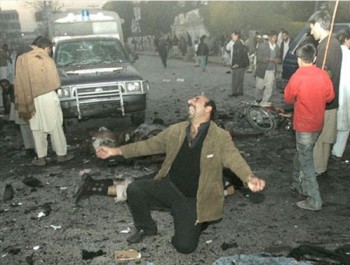
iMEDIAETHICS FOUND UNNAMED MAN IN BROWN JACKET WHO BECAME ICON FOR PAKISTAN'S GRIEF: CBS News Early Show, Dec 27, 2007 caption: "A supporter of Pakistan former Prime Minister Benazir Bhutto mourns deaths of his colleagues after a suicide attack in Rawalpindi, Pakistan, Dec. 27, 2007. [Photo: AP Photo/B.K.Bangash]" Problem is CBS News had no idea if the unnamed man in the brown jacket was, in fact, a "supporter."
Brown Jacket Man became an instant icon of grief for the American media and a symbol for the shock and horror of the Pakistani people in reaction to the Bhutto murder that stole 24 lives.
Media outlets such as ABC and NBC News, as reported by Wonkette, cropped out or blurred the felled men— husbands, sons, fathers, brothers, uncles, cousins, friends — now reported as impersonal hunks of flesh. Others, like the New York Times, published graphic photos of the carnage. In what clearly constitutes an ethical double standard, Pakistani victims were treated with less regard than would be afforded American victims, whose dignity would have been protected (presumably out of sensitivity to victims’ families and possible public backlash).
 Wonkette reported that NBC News blurred the blood and gore |
 Wonkette compared NBC News’ image to the original Getty photo |
It is unimaginable that even one news photo of the literally thousands of body parts and victims’ splattered remains would similarly be published by the New York Times following the World Trade Center attacks on September 11, 2001.
One can imagine the overwhelming reaction such news photos from the 9/11 attacks would ignite from the American public. Sources for outcries would include victim families’ organizations, firefighter unions, ethicists — all amounting to a public relations nightmare as they serve as vocal advocates who do not think twice about protesting what they perceive as unethical media conduct to media advertisers.
By contrast, Muammar Gaddafi’s recent murder by a mob generated some public outcry, both here in the U.S. and internationally in English-language media. For example, in Newsweek’s Nov. 7 & 14 2011 print issue, a letter to the editor from Erika Giles, a reader from Mercer Island, Wash.:
“I was appalled that you published the photo of Muammar Gaddafi’s barely clothed dead body covered in blood. Yes, he was a tyrant and Libya is better off without him, but there are certain boundaries that shouldn’t be crossed. I expected better of you.”
 The Guardian, front page |
 New York Daily News story with linked video about sodomy of the former leader. The Daily News front page also depicted a bloody image of Muammar Gaddafi. |
Likewise, a reader named H. Jayasundere wrote a letter to the Sri Lanka Sunday Times :
Letter – Where was media ethics when Gaddafi was killed?
“Media guidelines and ethics are often shoved down the throats of those in developing countries in an attempt to make them more ‘civilized’ and bring them up to ‘international standards’. Yet, when Libyan leader Muammar Gaddafi was killed, the indignity of his last moments; his torture and death were repeatedly televised over international media networks.
“For days people watched with shock, the humiliation meted out to someone who was once one of Africa’s most well-known leaders. Mobile phone footage of the moments before his death followed by continuous shots of his half naked body on display was disturbing.
“Although Muslims perform funeral rites within 24 hours of a death, his body and that of his son’s were on callous display for four days.
“If this event had taken place in any other (non oil-rich) country with no backing from NATO, there would have been a huge outcry about human rights violations, which is what it was.”
Grisly news images showed the former Libyan leader pummeled, bloodied, dying and dead above the folds and as featured videos — all purchased by media or donated from mob members’ cell phone footage. One video sequence, published by the New York Daily News, purportedly showed Gaddafi being sodomized with a knife, labeling the act a “final humiliation” that the newspaper nonetheless had no qualms about publishing.
In the case of the Bhutto crime scene, our special interactive news photo analysis shows Brown Jacket Man was followed by photojournalists as he roamed through the debris field and stopped to gesticulate with great emotion among the downed motorcycle, exploded vehicles and the dead and injured. Brown Jacket Man was, in fact, wandering for a significant length of time. Click map to enlarge and go interactive.
The Associated Press (AP) timestamps, receding daylight and Brown Jacket Man’s movements across the debris field, indicate he was on-scene for hours — plenty of time for photographers to ask his name.
 (Credit: Associated Press) |
 (Credit: Associated Press) |
Yet the AP caption for a series of images by B.K. Bangash depicting Brown Jacket Man states:
“A supporter of Pakistan former Prime Minister Benazir Bhutto mourns deaths of his colleagues after a suicide attack in Rawalpindi, Pakistan, Thursday, Dec. 27, 2007.”
How does the AP know he was a “supporter” of Mrs. Bhutto if it doesn’t have so much as his name? The AP also states that the supporter “mourns deaths of his colleagues.” But did Brown Jacket Man even know any victim? Finally, why didn’t any of the handful of photojournalists trailing Brown Jacket Man get his name?
 Brown jacket man on page 1 |
 Brown jacket man on page 1 |
We asked these questions of the six photojournalists in our interactive news photo crime scene analysis. Adam Dean, a freelance photojournalist living in Beijing, responded by email on Jan. 9, 2008, when we began our research. The AP and John Moore, whose Getty images were published by The New York Times, did not answer our questions. Dean wrote:
“I am afraid I did not get any names or details of subjects from the bomb. If it is the guy screaming and looking very emotional I believe the guy was a Bhutto/PPP supporter who was overcome with emotion after the attack. Unfortunately I can’t give you any more details as you can imagine it wasn’t really a time to start asking for names and background. …”
But many photos, including from the AP, show Brown Jacket Man crowded in the darkness, calmly walking and standing around.
 Brown jacket man on scene into late hours. See our red circle above (Credit: AFP/Getty Images) |
 (Credit: AFP/Getty Images) |
|
AP Refused to Correct Time Stamps that Wrongly Date Bhutto Murder Before it Happened : TIME LINE: Morning, GMT Dec 27, 2007 : Thousands of Pakistani citizens gathered in Liaqat Bhag Park of Rawalpindi early in the morning. It was a historic event called by Benazir Bhutto and arranged by the Pakistan People Party workers before the general elections. Mrs. Bhutto was the candidate for the next premiership. 1:53 p.m. GMT : Associated Press (AP) Creation Time Stamp for Image ID 07122705584. Photo shows Bhutto murder scene that featured an unnamed, emotional man wearing a brown jacket before it happens later at 5:16pm. The AP’s captions states as fact –even though they were guessing–that: “A supporter of Pakistan former Prime Minister Benazir Bhutto mourns deaths of his colleagues after a suicide attack in Rawalpindi, Pakistan, Thursday, Dec. 27, 2007. ” AP had no idea if the man was a supporter or if he lost anyone he knew that day. 2:13 p.m. GMT : AP Creation Time Stamp for Image ID 07122705744. Photo shows Bhutto murder scene that featured an unnamed, emotional man wearing a brown jacket before it happens later at 5:16pm. The AP’s captions states as fact –even though they were guessing–that: “A supporter of Pakistan former Prime Minister Benazir Bhutto mourns deaths of his colleagues after a suicide attack in Rawalpindi, Pakistan, Thursday, Dec. 27, 2007. ” AP had no idea if the man was a supporter or if he lost anyone he knew that day. 3:00 p.m. GMT: Benazir Bhutto arrived at Liaqat Bhag Park and spoke to the crowd. 4:10 p.m. GMT : AP Creation Time Stamp for Image ID 07122707902. Photo shows Bhutto murder scene that featured an unnamed, emotional man wearing a brown jacket before it happens later at 5:16pm. The AP’s captions states as fact –even though they were guessing–that: “A supporter of Pakistan former Prime Minister Benazir Bhutto mourns deaths of his colleagues after a suicide attack in Rawalpindi, Pakistan, Thursday, Dec. 27, 2007. ” AP had no idea if the man was a supporter or if he lost anyone he knew that day. 5:07 p.m. GMT: Beginning of sunset 5:15 p.m. GMT: Mrs. Bhutto finished her speech, got on board her vehicle and came out from the sunroof to wave her hands in appreciation for the public response. 5:16 p.m GMT: Bomb and bullet attack 5:17 p.m GMT: Mrs. Bhutto was rushed to General Hospital Rawalpindi after being killed instantly according to doctors and media reports. 9:24 p.m. GMT: AP Creation Time Stamp for Image ID 07122705254. Photo shows grisly crime scene in the darkness. This could be a legitimate timestamp but iMediaEthics or the public has no way of knowing. AP refused our multiple requests to check this and the others time stamps’ accuracy. Despite our pointing out the obvious that the photo time stamps are incorrect in their data base–AP made excuses but no corrections. Morning, Dec 28, 2007: Unnamed, emotional man in a brown jacket becomes icon on the front pages of newspapers around the world as he gesticulates wildly amid the body parts and slicks of blood and vehicle debris. The AP’s captions states as fact –even though they were guessing–that “A supporter of Pakistan former Prime Minister Benazir Bhutto mourns deaths of his colleagues after a suicide attack in Rawalpindi, Pakistan, Thursday, Dec. 27, 2007. ” The American media published grisly images of dismembered Pakistanisa clear double standard. No maimed American victims, such as in the 9/11 attacks, are shown in similar state of dismemberment.
The timeline above uses the GMT time zone from the AP’s 2007 time stamp along with the local GMT+5 time zone. When we tried to put the time line into only the GMT+5, Pakistan’s time zone, the time stamp problems got worse–even changing one photo’s date from Dec 27th to the 28th. More on this in parts 4 and 5 of our series. |
We found Brown Jacket Man
Brown Jacket Man has a name, Muhammad Yaseen Khan. We visited his home. He is a husband and father and was also a close aide to former slain leader Mrs. Bhutto, serving as a driver in the National Assembly of Pakistan (as evidenced by photos in his home and confirmed by party leadership). See our exclusive interview with Yaseen in Part 2 and Part 3.
 Image hangs on Mr. Yaseen’s (also known as brown jacket man) home wall |
Yaseen showed us photos picturing him with Bhutto in his home
Yaseen did not know any of the dead or injured beyond Bhutto at the time he was being photographed. He did experience a brush with death that same day when the truck he was walking alongside was among those that exploded. While others near him were killed, he was uninjured but for superficial wounds and psychological scars.
Yaseen showed us a scrapbook filled with press clippings from around the world that featured images of him — many sent to him by the press. He reports that four years later he still has trouble sleeping and suffers from nightmares.
 From Mr. Yaseen’s keepsake photo album. Yaseen showed iMediaEthics a scrapbook of media photographs of him at the Bhutto assassination scene. |
No media outlet has published his name or background until now.
Like one’s body, one’s name and identity is also sacred and part of one’s dignity in the majority of world cultures.
Yaseen is more than an icon or brown person from a faraway land. Like the other victims of the Dec. 27, 2007 horror, he is a son to someone, just as he would be were he American.
The West’s standards of decency shouldn’t be limited to Western subjects, said Mahoomda Ghazai, a senior journalism professor in the visiting faculty of Fatima Jinnah Woman University Rawalpindi, when we contacted her for comment. “Yes, the West have double standards in all the fields of Pakistan and Third World countries,” she said. “It is shameful and really pathetic to publish such kinds of images as the human bodies looking naked and wrapped in blood.
“All these tall claims of the U.S. towards the media ethics [is] proved wrong by such kinds of double standards,” she continued, “and this [reveals] the bias and hypocrisy of the U.S. media.”
Rethinking graphic images and the double standard
In an entry dated Feb. 10, 2010 on her blog Real Media Ethics, Anne Kosseff, a writer and editor, explained that she has re-thought her “ideas about the publication of graphic photographs of natural disaster aftermaths.” She stated: “The devastating earthquake in Haiti this month has raised the issue again, as photos of dead bodies have made it to the print and virtual front pages of most major news organizations.”
Kosseff also identified the disturbing double standard when she wrote:
One of the most troubling elements of graphic photographs of distant tragedies is inadvertently emphasized in [Washington Post Ombudsman Andrew] Alexander’s January 24 Post column, which explains almost in passing that some newspapers (no mention of whether the Post was among them) “shy from running explicit photos of deaths in their circulation area because many readers may be connected to the deceased.” Alexander goes on, “In the case of Haiti, [director of the School of Visual Communication at Ohio University Terry] Eiler said, ‘Distance allows some to feel as if it’s happening away from us.’ ” The idea that such images are more likely to be used when the reader feels distance from the subjects lends credence to critiques that graphic depictions of death create (or exacerbate) a sense of “otherness” about the victims they portray.
If audiences are only exposed to photos of dead bodies when the people pictured can be classified as somehow “different” (geographically, racially or socioeconomically) from the majority of the publication’s readership, then the photos themselves become a marker of difference. They might actually create emotional distance from victims, even as they accentuate the visceral horror of the event they are representing.*
*I do not mean to suggest that audiences of U.S. news publications are uniformly white or non-Haitian, only that most audience members will at least be physically distant from the victims, and many others will share one or more other markers of difference from the victims portrayed.
News photo editors need to think directly about not treating brown people differently from white Americans.
When a torn-off arm or leg is depicted indeed with the universality of the Internet, a family member of a victim is likely to see the gruesome images and even wonder, Is this my loved one’s limb? Yaseen told us in our exclusive interview that he later recognized people in publications showing photos of dismembered victims.
Editors ought to adopt the Golden Rule. Think about how you would feel if the photograph of a headless torso with clothing you recognize as belonging to a murdered family member was carried above the fold in the New York Times, while American or light-skinned victims’ remains are cropped or blurred?
All journalists and editors have an obligation to treat all human beings with the same ethical values and policies.
Finally, editors need to ensure captions properly identify the people depicted when possible. Yaseen, nameless in the news throughout the world, could have been asked for his name on-scene or later, as we have done.
As Paul Martin Lester, a California State University, Fullerton professor and expert on photojournalism ethics wrote to us by email on April 23, 2008, “Captions should be as accurate as possible.”
Indeed, the unnamed man in the brown jacket, Yaseen, so featured in the AP coverage, did not know at the time he was photographed any of the 23 dead beyond Bhutto. Yet the AP was willing to suggest that he did and further claim that he was a “supporter” of Bhutto whether it knew he was or not.
UPDATE: 12/30/2011 1:45 PM EST: We will be publishing Parts 4 and 5 next week. In those reports, we will address the inaccurate time stamps and speculative captions.The timeline above uses the GMT time zone from the AP’s 2007 time stamp along with the local GMT+5 time zone. When we tried to put the time line into only the GMT+5, Pakistan’s time zone, the time stamp problems got worse–even changing one photo’s date from Dec 27th to the 28th. More on this in parts 4 and 5 of our series.
UPDATE: See Part 2 , Part 3, and Part 4 of this investigation.






